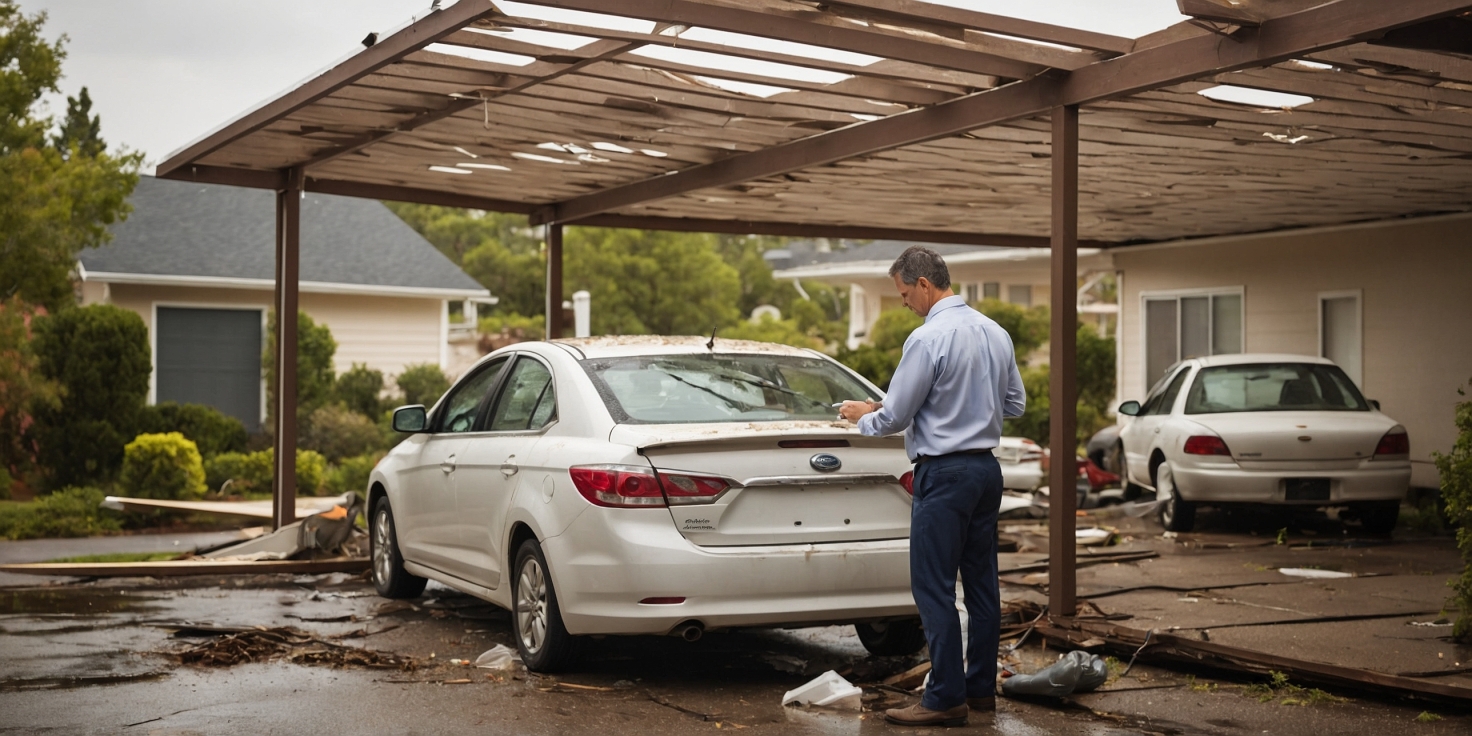Understanding Carport Damage and Insurance Coverage
Let’s be honest—carports don’t always get the attention they deserve. They’re like the unsung heroes of your property, quietly shielding your car from the elements. But when disaster strikes—be it a hurricane, hailstorm, or even a fallen tree—your carport can take a serious hit. That’s when the real challenge begins: navigating the maze of insurance claims.
First things first, let’s talk about what kind of damage is typically covered. Most homeowners insurance policies will cover carport damage if it’s caused by a covered peril like wind, hail, or fire. However, if the damage is due to wear and tear or poor maintenance, you might be out of luck. That’s why it’s crucial to understand the specifics of your policy.
Now, if you’re in South Florida, you’re no stranger to extreme weather. Hurricanes and tropical storms are part of life here, and they can wreak havoc on structures like carports. That’s where LMR Public Adjusters come in. As South Florida’s premier public adjusters, they specialize in helping property owners like you maximize your insurance claims. Their personalized, dedicated team knows the ins and outs of insurance policies and will advocate on your behalf every step of the way.
Before you even file a claim, it’s a good idea to review your policy. Look for terms like “other structures coverage” or “detached structures.” These are the sections that usually apply to carports. If you’re unsure, don’t hesitate to reach out to a professional for a policy review. You can also check out the FAQ section on LMR’s website for more guidance.
Understanding your coverage is the foundation of a successful claim. Without it, you’re essentially walking into a negotiation blindfolded. So take the time to read through your policy, highlight key terms, and consult with experts if needed. It’s the first step in turning a stressful situation into a manageable one.
Need more info on property damage claims? Visit our Property Claims page for detailed insights.
Documenting the Damage: Why Photos and Notes Matter
Alright, so your carport’s been damaged. Maybe a storm rolled through and left it looking like a crumpled soda can. What now? Before you even think about calling your insurance company, grab your phone or camera. Documentation is your best friend in this process.
Start by taking wide-angle shots of the entire carport to show the full extent of the damage. Then, zoom in on specific areas—bent beams, torn roofing, broken supports. Don’t forget to snap photos of any debris or fallen trees that may have caused the damage. The more visual evidence you have, the stronger your claim will be.
But don’t stop at photos. Take notes. Write down the date and time the damage occurred, what the weather was like, and any other relevant details. If you heard a loud crash during the storm or noticed water pooling near the base, jot it down. These details can help paint a clearer picture for your insurance adjuster.
And here’s a pro tip: keep a damage diary. Every time you notice something new or take an action related to the damage, write it down. This can include phone calls with your insurer, visits from contractors, or even conversations with neighbors who witnessed the event.
LMR Public Adjusters recommends creating a digital folder to store all your documentation. That way, everything is in one place when it’s time to file your claim. You can even upload your photos and notes to the cloud for easy access. If you’re unsure what to document, check out our blog for tips on how to prepare for property damage claims.
Remember, insurance companies aren’t in the business of handing out money. They need proof, and the burden of that proof falls on you. So be thorough, be organized, and don’t leave anything to chance.
Filing the Insurance Claim: Step-by-Step
Filing an insurance claim might sound as fun as a root canal, but it doesn’t have to be a nightmare. With the right approach, you can get through it smoothly—and even come out ahead. Here’s a step-by-step guide to help you navigate the process like a pro.
Step 1: Contact Your Insurance Company
As soon as you’ve documented the damage, call your insurance provider. Most companies have a 24/7 claims hotline. Be ready to provide your policy number, a description of the damage, and the date it occurred.
Step 2: Submit Your Documentation
This is where all those photos and notes come in handy. Submit them along with your claim form. The more evidence you provide, the better your chances of a fair settlement.
Step 3: Schedule an Adjuster Visit
Your insurer will send out an adjuster to inspect the damage. This is a critical moment in the process. Make sure you’re present during the inspection so you can point out all the damage and answer any questions.
Step 4: Get Repair Estimates
Even if your insurance company provides an estimate, it’s a good idea to get your own. Contact a few licensed contractors and ask for written quotes. This gives you leverage if the insurer’s offer seems low.
Step 5: Review the Settlement Offer
Once the adjuster completes their report, your insurer will send you a settlement offer. Don’t feel pressured to accept it right away. Review it carefully and compare it to your repair estimates.
If you feel the offer is too low, that’s where LMR Public Adjusters can step in. Their team will review your claim, negotiate with the insurance company, and fight to get you the compensation you deserve. Learn more about their services on the Home Damaged page.
Filing a claim is a process, not a sprint. Take your time, stay organized, and don’t be afraid to ask for help.
Working with a Public Adjuster: Why It’s a Game-Changer
Let’s face it—insurance companies have one goal: to minimize payouts. That’s why having a public adjuster in your corner can be a total game-changer. Think of them as your personal advocate, someone who knows the system inside and out and is committed to getting you the best possible outcome.
So, what exactly does a public adjuster do? They evaluate your damage, review your policy, prepare your claim, and negotiate with the insurance company on your behalf. Unlike the adjuster sent by your insurer, a public adjuster works for you—not the insurance company.
In South Florida, LMR Public Adjusters are the go-to experts. With years of experience and a personalized approach, they’ve helped countless homeowners and business owners recover from property damage. Whether you’re dealing with wind damage, water damage, or even mold issues, their team knows how to maximize your claim.
One of the biggest benefits of working with a public adjuster is peace of mind. Instead of stressing over paperwork and negotiations, you can focus on getting your life back to normal. Plus, public adjusters often uncover damages that insurance adjusters overlook, which can significantly increase your payout.
Still on the fence? Check out the Google Reviews for LMR Public Adjusters. Their clients rave about the professionalism, dedication, and results they deliver.
Bottom line: if you want to level the playing field and ensure you’re not leaving money on the table, hiring a public adjuster is a smart move.
Common Mistakes to Avoid When Filing a Claim
Filing an insurance claim might seem straightforward, but there are plenty of pitfalls that can trip you up. Avoiding these common mistakes can save you time, money, and a whole lot of frustration.
1. Waiting Too Long to File
Time is of the essence when it comes to insurance claims. Most policies have strict deadlines, and waiting too long can result in a denied claim. As soon as you notice damage, start the process.
2. Incomplete Documentation
We can’t stress this enough—document everything. Skipping this step or providing vague information can weaken your claim. Be thorough and organized from the start.
3. Accepting the First Offer
Insurance companies often lowball their initial offers. Don’t accept it without reviewing it carefully and comparing it to your repair estimates. If it doesn’t add up, push back.
4. Not Reading Your Policy
Your insurance policy is your roadmap. If you don’t understand it, you’re at a disadvantage. Take the time to read it or consult with a professional who can explain it to you.
5. Going It Alone
Handling a claim solo can be overwhelming. That’s why many homeowners turn to Plantation Public Adjusters or Pembroke Pines Public Adjusters from LMR for expert help. Their team knows how to navigate the system and fight for your rights.
By steering clear of these common mistakes, you’ll be in a much better position to get the compensation you deserve.
Conclusion
Dealing with carport damage is stressful enough without having to battle your insurance company. But with the right knowledge, documentation, and support, you can turn a frustrating situation into a successful claim. From understanding your policy to working with a public adjuster, every step you take brings you closer to a fair settlement.
And remember, you don’t have to go it alone. LMR Public Adjusters—South Florida’s premier public adjusters—are here to help. Their personalized, dedicated team will advocate for you every step of the way, ensuring you get the compensation you’re entitled to. Visit their location page to find an office near you or explore their commercial property services if you’re a business owner.
So the next time your carport takes a hit, don’t panic—take action. With the right approach and the right team, you’ll be back on track in no time.
What kind of carport damage is typically covered by insurance?
Most homeowners insurance policies cover carport damage caused by events like wind, hail, fire, or falling objects. However, damage due to wear and tear or poor maintenance is usually not covered. Always check your policy for specific details.
How long do I have to file a carport damage claim?
It varies by policy, but most insurers require you to file a claim within a certain timeframe—often 30 to 60 days after the damage occurs. Check your policy or consult with a public adjuster to avoid missing deadlines.
Can I handle the insurance claim myself?
Yes, but it can be complex and time-consuming. Hiring a public adjuster like LMR Public Adjusters can significantly improve your chances of a higher payout and reduce your stress during the process.
What should I do if my claim is denied?
If your claim is denied, don’t give up. Review the denial letter carefully and consult with a public adjuster. They can help you appeal the decision and provide additional documentation to support your case.
How do I find a reliable public adjuster in South Florida?
Start by checking reviews and credentials. LMR Public Adjusters are highly rated and have a strong reputation across South Florida. Visit their Google Reviews page to see what clients are saying.




